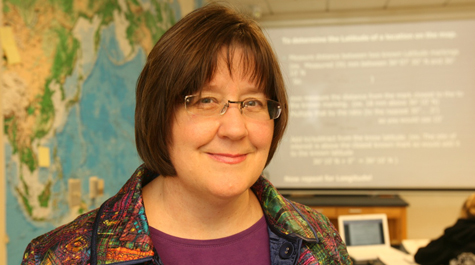Geosciences site wins ‘Science’ prize
AAAS awarded the group its Science Prize for Online Resources in Education (SPORE) for the group’s website “On the Cutting Edge.” In addition to Macdonald, Chancellor Professor of Geology at William & Mary, the group includes David Mogk of Montana State University, Barbara Tewksbury of Hamilton College and Cathryn Manduca of Carleton College.
Macdonald notes that the SPORE-winning web site is based at Carleton’s Science Education Resource Center, where Manduca is director. Several staff members of the center were honored as well. The web site is an integral part of the professional development program, also called On the Cutting Edge, which has received considerable support, including a total of $6.2 million in grants from the National Science Foundation.
“The web site is built from the workshops,” Macdonald explained, “but it also extends the reach of the workshops, to make materials and ideas and resources accessible to geoscience faculty, both current and future.”
Since 2002, the Cutting Edge initiative has conducted around six workshops a year across the country and Macdonald says the group is offering several virtual and face-to-face workshops this coming year. A story in Science magazine announcing the prize notes that approximately 1,400 faculty members from more than 450 colleges and universities have participated in Cutting Edge workshops.
“From the very beginning we wanted to have an integrated program that included both the web site and the workshops,” she said. “We now require workshop participants to contribute something that will be a part of the online resources.”
“Cutting Edge,” the web site, contains information and materials organized into 33 topical sections. The resources include 1,200 activities contributed by teachers in the geosciences. The activities include ideas for interactive classroom discussions, field exercises and lab activities.
“If you are going to teach a class on, say, landslides or earthquakes or tsunamis, you can go to our web site and look for resources,” Macdonald said. “As you prepare for the class, you can see what other geoscience faculty have done on that topic.”
Macdonald’s emphasis in the project is directed toward new faculty in the geosciences. The web site holds a prominent section containing a wealth of information and advice on subjects ranging from finding the first job to setting up a research program to getting tenure. Much of the subject matter deals with classroom technique and other instructional skills.
“We want to promote teaching that is student-centered,” she said. “That might range from ideas about how to teach large lecture courses—which many faculty have to do, especially when they’re new to thinking of what you want students to know and be able to do after they take your course.”
The web site contains ideas for keeping a research seminar fresh and techniques for engaging students. The Teaching Large Classes section contains a wealth of tested best practices involving collaborative learning techniques, the use of technology and instructional techniques, many of which were explained in detail at Macdonald’s workshops for early-career faculty.
“For instance, at our workshop last year, Greg Hancock—a faculty member in the geology department—led a session on interactive lectures,” Macdonald said. “He demonstrated a way to incorporate questioning students in a way that the whole class winds up working on the answer to the questions that are posed—even in a large lecture class.”
Hancock’s demonstration was videotaped for inclusion on the Cutting Edge web site, among the other resources there. “The participants in the workshop heard it live,” Macdonald explained, “but through the web site, the larger world of geoscience faculty can also benefit.”
Macdonald has been recognized before for her outreach work on behalf of geoscience instruction and faculty. In 2009, she was the recipient of the Neil Miner Award, an honor bestowed by the National Association of Geoscience Teachers.
 Skip to main content
Skip to main content

